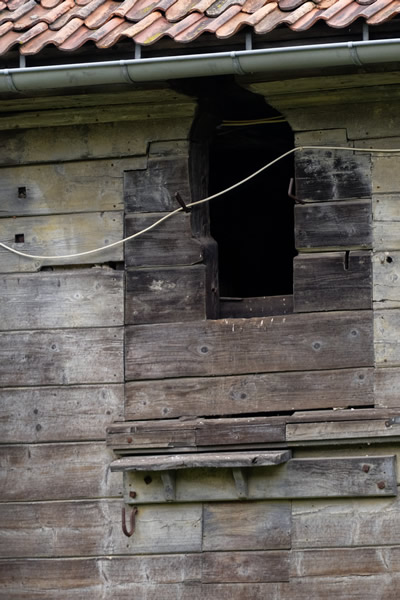Every large iron foundry used to have a workshop with machines. This building on the Königshütte was probably erected in 1815 and later extended. In the records there is talk of a drilling and turning mill. Like the iron store, it originally consisted of two wings connected by a transverse building on the courtyard side. The two former entrances are clearly visible to the left and right of the porch. The large window openings, which brought the necessary daylight into the workshop for the workers of the 19th century, at a time when there was no electric light, are striking. The upper floor used to house the bronzing workshop, a packing room and model rooms.
The view into this machine factory is impressive: one feels transported into the 19th century: In the period after the privatisation of the ironworks, the machine factory was considerably extended in 1875. Thus the two wings of the building were joined into one large workshop building by a roof and a transverse building at the rear. In the years 1920-21 the front building was added in the half-timbered construction. Also the interior underwent some alterations. The smithy received a special building. Through the shed roofs, light falls into the workshop from above and then allows to work on the huge facing lathe in daylight. This is indeed an eye catcher for every visitor. It was manufactured in Chemnitz in 1875 and is therefore the oldest machine in this factory that can still be worked on. With a clamping possibility of 3m diameter it might be quite unique in the district of Göttingen. To be able to bring the heavy parts to the machine, a crane track was built, which starts in the front building. Remarkable is the floor in front of this machine, made of end-grain wood pavement. Some machines are still driven by a belt transmission, like everywhere in the 19th century.

Opening for transmission at the engine house
The original drive for all machine tools came from a water wheel with a diameter of 5.24m, which was located behind the building. The necessary water flowed from the first slope underground to the drive wheel. However, this drive was too weak for other machines. After privatisation, a wire rope from the former rolling mill building opposite drove the machines. This drive cable crossed the entire smelting works yard at a certain height until it reached a large opening on the left front side in the upper floor of the machine factory, where it can still be seen today. Before 1887 a small locomobile of the Lanz company/Mannheim was placed in front of the building, which could provide further driving power for the machine factory.
Since about 1880 the Königshütte machine factory advertised steam engines "according to the latest construction with the lowest possible consumption of fuel, steam pumps, turbines and water wheels, complete mill equipment, crushing, grinding and milling roller mills with patented filling device, purifiers". In the period from 1882 to 1925, 287 mill installations were manufactured and delivered by the Königshütte mill construction company! Around 1900 the good order situation made a working time of 12 hours per day necessary. Until about 1990 the delivery programme of Königshütte included machine equipment for the gypsum industry. The gypsum cooker ("Harzer Kocher") was an important mainstay for the Königshütte company, which had also supplied complete gypsum works plants for the production of the various types of gypsum for purposes of the building industry, the ceramic industry, the dental sector etc. all over the world.
The earliest gypsum factory plants were built by Königshütte in in the village of Ellrich, in Transylvania, Switzerland, and before the First World War also in Russia. After the Second World War, orders came from Indonesia and South America, just to name but a few countries.
